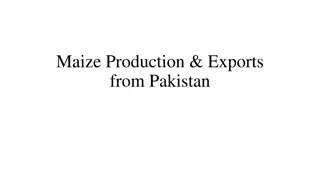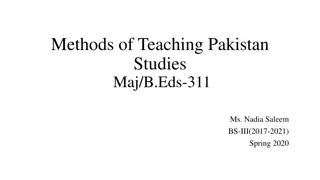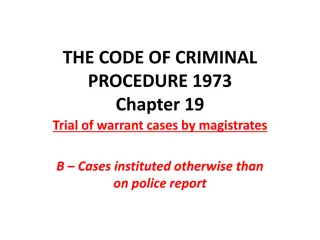Rejection of Plaint under the Code of Civil Procedure in Pakistan
The Code of Civil Procedure in Pakistan governs the administration of civil justice, with provisions for rejecting a plaintiff's claim under specific circumstances. Grounds for rejection include insufficiently disclosing the cause of action, improper valuation of relief, insufficient stamping on paper, or if the suit is barred by law. Understanding the concept of cause of action and following precedents are crucial in determining the legitimacy of a plaintiff's claim.
Download Presentation

Please find below an Image/Link to download the presentation.
The content on the website is provided AS IS for your information and personal use only. It may not be sold, licensed, or shared on other websites without obtaining consent from the author. Download presentation by click this link. If you encounter any issues during the download, it is possible that the publisher has removed the file from their server.
E N D
Presentation Transcript
REJECTION OF PLAINT IN THE LIGHT OF THE STATUTE & PRECEDENTS OF SUPERIOR COURTS OF PAKISTAN Presented By Zulfiqar Ahmad Khan Civil Judge/JM- I , Balakot
INTRODUCTION: The Code of Civil Procedure, 1908, is a procedural law related to administration of civil justice. It has two parts: The first part contains 158 sections, and The second part contains the first schedule which has 51 orders and rules. The former part pertains to the general principles of jurisdiction, while the latter part prescribes procedures and methods which govern civil justice system.
REJECTION OF THE PLAINT plaint. The plaint can be rejected by the court on its own motion or upon application of party if conditions mentioned ibid are fulfilled. Order-VII rule 11, of the Code of Civil Procedure, 1908, discusses rejection of the Return of the plaint is concerned with the question of jurisdiction of the Court whereas Rejection of plaint with the maintainability of the suit. There is a stark difference between rejection of the plaint and return of the plaint.
GROUNDS FOR REJECTION OF PLAINT: The plaint shall be rejected in the following cases:- When it does not disclose Cause of Action Where the relief(s) claimed is / are inappropriately valued Where the plaint is written on paper insufficiently stamped Where the suit is barred by law.
A. CAUSE OF ACTION: A cause of action is the legal notion for the set of facts which give rise to a claim enforceable in court. The term cause of action has been mentioned in CPC in as many as 26 places such as: Order-II rule 2, CPC, which prevents splitting of claims and mandates that all the claims based on same cause of action against the same party should be included in one suit. Order-VII rule 1, s, it states that plaint shall contain facts constituting the cause of action and when it arose beside other particulars. Order-IX rule 9, ibid, it states that when suit is dismissed due to absence of plaintiff, then plaintiff is debarred from bringing fresh suit on same cause of action. Section 20 (c), ibid, which states, beside other grounds, every suit shall be instituted in a court within local limits of whose jurisdiction the cause of action, wholly or partially, arises.
PRECENDENTS ON CAUSE OF ACTION: In PLD 2002 408 Karachi-the Hon ble Sindh High Court & in 2010 PLD 65 Quetta-High Court Baluchistan held that there is a difference between plaintiff having no cause of action and plaint disclosing no cause of action. Plaintiff having cause of action or not could only be determined on the basis of evidence. However, Plaint could be rejected under Order-VII rule 11 CPC only if the same did not disclose a cause of action. Similar view is taken by the Hon ble Peshawar High Court, Peshawar, in case titled, Ismail VERSUS Syed Zulfiqar Hussain Shah reported as 2021 PLD Page 98 , that there is a different between non- accrual of cause of action and non-disclosure of cause of action. Non-accrual of cause of action results into dismissal of suit after recording of evidence whereas non-disclosure of cause of action results into rejection of plaint.
DISTINCTION There may be disclosure of cause of action without accrual of the same e.g. when certain time is fixed for the performance of an agreement, the institution of suit for specific performance is declared premature. Limitation Act 1908, Section 3; Schedule 1, Article 113.
B. RELIEF WRONGLY VALUED Valuation of a suit is meant: i. For determining the pecuniary jurisdiction of court in which it should be filed, and ii. For determination of court fees to be paid. Initial duty of determination of proper valuation of relief is upon the plaintiff under the newly inserted Section 26, CPC, it is the duty of court on the very first day when the suit is filed. Trial court has also authority to change valuation of suit either on its own motion or on objection by defendant under section 11 of Suits Valuation Act, 1887. (2016 PLD 409 Supreme Court) Objection as to jurisdiction - if neither raised in court of first instance nor in court of appeal, it should not be allowed to be raised afterwards. Reliance placed upon: 1956 PLD 214 Lahore High Court 1986 MLD 1182 Lahore High Court 1986 PLD 242 Lahore High Court 1989 MLD 1776 Sindh High Court 1992 MLD 1309 Supreme Court 2001 YLR 3280 Supreme Court
When trial court accepts the plaint after objection or makes its own determination, which is accepted by the plaintiff, then it is the end of the matter and thereafter all the proceedings must be controlled by valuation so fixed by the court. Wisdom is drawn from 1989 CLC 1515 Lahore High Court. Court has the power to extend time already granted, if sufficient reasons are put forth. 2020 YLR 745 LHC,2019 MLD 2029 PHC Forum of appeal would be determined by that valuation fixed by the court or in case when court has not determined then by the plaintiff under section 3 of suits and valuation Act.
C. IMPROPER STAMP The court has ultimate duty to determine the proper court fees payable by the plaintiff and grant the reasonable time to make good the deficiency of court fee. The court has discretionary power to extent time granted unless there is contumacy, gross negligence and malafide under section 148 and 149 CPC 1984 CLC 1189 In case if the plaint is not properly stamped or insufficiently stamped , it is no plaint in the eyes of law and there is no suit instituted in 1967 PLD 154 LHC
D. SUIT BARRED BY LAW LAW: The law means written law or statute law and is used in generic sense. PLD 1990 Lah 222 Law means a formal pronouncement of the will of a competent law-giver. PLD 1977 SC 397 Law includes- constitution, statutes, judicial principles, rules, bye-laws etc. PLD 1997 SC 84 The notion law here denotes any law for the time-being in force in Pakistan and does not include obsolete laws or foreign laws. Moreover, a suit being barred by the law means and includes being barred by any special law, e.g. The Limitation Act, 1908. So, when we say that a suit is time-barred, it manifestly denotes that the same is barred by the law of limitation i.e. The Limitation Act, 1908.
ILLUSTRATIONS: The relief relinquished in respect of one cause of action is barred under Order II Rule 2 of C.P.C 1908. The suit hit by principle of res-judicata is barred under section 11 of C.P.C The suit hit by doctrine of estoppel is barred under article 114 of Qanun-e-Shahadat Order 1984. When suit withdrawn without permission, fresh suit barred on same cause of action under Order XXIII Rule 3 read with section 12(1) CPC. The suit for permanent injunction restraining public functionaries from official functions is barred under section 56 (d) of Specific Relief Act, 1877.
GENERAL PRINCIPLES: Contents of the plaint. Overlook written statement. The above general rule has two exceptions- (i)Documents admitted by plaintiff annexed with plaint. (ii)When plea of res- judicata or time barred suit is advanced in written statement.
The plaint is not to be rejected when amendment of plaint is permissible under the law. (2021 PLD 688 LHC) Even when one of the relief is maintainable, suit cannot be rejected under Order-VII rule 11 CPC. (2021 CLC 981 LHC) The rejection of plaint is decree (by fiction of law, for the purpose of appeal) as defined in sub-section (2) of the Section 2 of CPC. The order of rejection of plaint is appealable whereas order of refusal to reject plaint is revisable.
DISTINCTION BETWEEN REJECTION OF PLAINT & DISMISSAL OF SUIT Rejection of plaint opens door for plaintiff for filing fresh suit under order- VII rule 13 CPC but in case of dismissal of suit, no fresh suit could be filed and only statutory remedy was available against dismissal order. (2017 CLC 1660
CONCLUSION. The tool of Order VII rule 11 CPC is applied to bury futile and fruitless suit at the very inception. Simultaneously, it also affords every opportunity to adjudicate upon the controversies on merits and to save the contesting parties from agony of frivolous and protracted litigation. The decision of using the option provided under Order-VII rule 11 CPC be taken with due consideration to facts and circumstances of the case.























